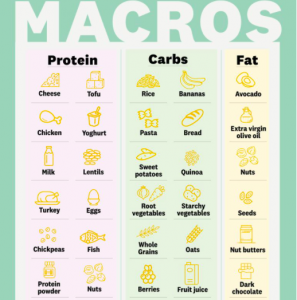Energy Balance, Body Weight and Health
Achieving a healthy weight involves getting the right ‘energy balance’. The amount of energy (calories) you consume needs to be balanced with the amount you use up through daily activities and exercise.
Staying the same weight relies on energy intake being balanced with energy burned.
If you take in more energy than your body needs, those extra calories are stored as fat, which leads to weight gain over time.
If you're trying to lose weight, your energy balance should be in ‘deficit’: the calories you take in should be less than calories you burn.

Three steps to healthy weight loss
1: Know how many calories you need
This CALORIE CALCULATOR helps you work out how many calories you need. It accounts for your age, weight and how active you are.
2: Know how many calories you should cut out
A healthy weight loss target is 0.5-2lb a week. This means a deficit of 250-1000 calories per day. Generally, the more weight you need to lose, the bigger the calorie deficit you can realistically aim for. But if you cut too much, then you will be too hungry and it will not be a sustainable change.
3: Plan how you’ll achieve your calorie deficit
You can achieve calorie deficit by consuming fewer calories and/or burning more through movement and exercise.
Here are some examples to help bring it to life:
Person 1 wants to lose 1lb per week. Most of her extra calories come from snacks and treats. She needs to make a deficit of 500kcal per day. Some ways he could achieve this are:
- Doing half an hour of running and cutting a 500ml bottle of coke out
- Skipping his visit to the coffee shop for a cappuccino and Danish
- Doing an hour of vigorous cycling or running
- Walking 20 minutes to and from work and choosing lighter and/or fewer snacks throughout the day
Person 2 wants to lose 2lb per week but struggles with portion sizes. She needs a deficit of around 1000kcal per day. Examples of how she could do this include:
- Switching from whole to skimmed milk with her cereal, reducing her lunch size from 2 sandwiches to 1 and not going for seconds at dinner
- Cycling vigorously for half an hour and cutting back from a bottle of wine to a glass
- Planning portion-controlled snacks throughout the day (e.g. a small packet of healthier crisps, an apple and a low-calorie snack bar over a sharing bag of crisps, a punnet of grapes and a packet of biscuits)
Note: these are rough guides. Calories burnt through exercise varies from person to person, and the number of calories in foods varies depending on the amount eaten, brand and so on. You can use the app, My Fitness Pal, for specific calories for food.
What are macro nutrients? Do I need to worry about these?
Macros is an abbreviation of the word 'macronutrient' and simply refers to the three main nutrient groups:
- Fats
- Carbohydrates
- Protein
The way you tally up your macros (e.g. what makes up your daily calories) can help you lose fat, maintain your weight or gain weight, depending on whether you're eating above or below the amount you're burning each day.
By counting your macros you can optimise your diet so that you're fuelling your body from the right sources by keeping your carb, fat and protein intake in balance.
Plus, it can help with the 'should I have this treat or not' scenario as you simply add your White Chocolate Magnum into your daily allowance of carbohydrates, fats and protein, and work the rest of your daily intake around it.
You can workout how many macronutrients (protein, carbohydrates and fats) your body needs each day based on your weight and daily activity levels. The calculation eventually gives you how many grams of carbohydrates, fat and protein you should be eating each day to hit your goals.
OR you can do with the percentage of at least 20% protein, no more than 55% carbs and the fat will fit in. It is likely that you macros will fluctuate from day to day - don't wirry about this as it is good to have a varied diet. If your Carb percentage is high then try to reduce the bread, rice, potato and pasta...
ALSO be aware that food sources contain more than one macro-nutrient. This is where the bar scanning tool on My Fitness Pal comes in really handy.
MACRO NUTRIENT CALCULATOR personalised to you
A reminder of what foods are in each macro group...

